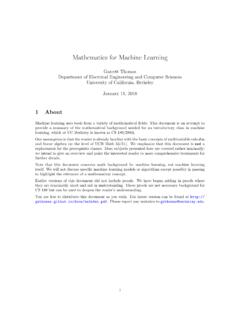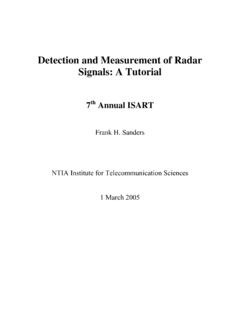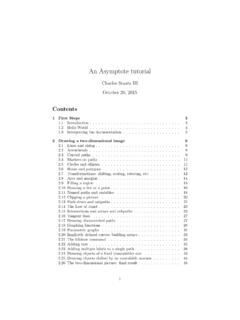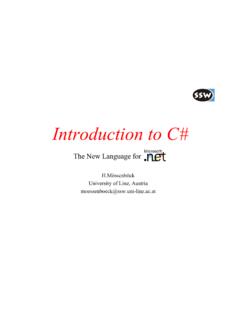Transcription of Mathematics for Machine Learning - GitHub Pages
1 Mathematics for Machine Learning Garrett Thomas Department of Electrical Engineering and Computer Sciences University of California, Berkeley January 11, 2018. 1 About Machine Learning uses tools from a variety of mathematical fields. This document is an attempt to provide a summary of the mathematical background needed for an introductory class in Machine Learning , which at UC Berkeley is known as CS 189/289A. Our assumption is that the reader is already familiar with the basic concepts of multivariable calculus and linear algebra (at the level of UCB Math 53/54). We emphasize that this document is not a replacement for the prerequisite classes. Most subjects presented here are covered rather minimally;. we intend to give an overview and point the interested reader to more comprehensive treatments for further details.
2 Note that this document concerns math background for Machine Learning , not Machine Learning itself. We will not discuss specific Machine Learning models or algorithms except possibly in passing to highlight the relevance of a mathematical concept. Earlier versions of this document did not include proofs. We have begun adding in proofs where they are reasonably short and aid in understanding. These proofs are not necessary background for CS 189 but can be used to deepen the reader's understanding. You are free to distribute this document as you wish. The latest version can be found at http://. Please report any mistakes to 1. Contents 1 About 1. 2 Notation 5. 3 Linear Algebra 6. Vector spaces .. 6. Euclidean space .. 6. Subspaces .. 7. Linear maps .. 7. The matrix of a linear map.
3 8. Nullspace, range .. 9. Metric spaces .. 9. Normed spaces .. 9. Inner product spaces .. 10. Pythagorean Theorem .. 11. Cauchy-Schwarz inequality .. 11. Orthogonal complements and projections .. 12. Eigenthings .. 15. Trace .. 15. Determinant .. 16. Orthogonal matrices .. 16. Symmetric matrices .. 17. Rayleigh quotients .. 17. Positive (semi-)definite matrices .. 18. The geometry of positive definite quadratic forms .. 19. Singular value decomposition .. 20. Fundamental Theorem of Linear Algebra .. 21. Operator and matrix norms .. 22. Low-rank approximation .. 24. Pseudoinverses .. 25. Some useful matrix identities .. 26. Matrix-vector product as linear combination of matrix columns .. 26. Sum of outer products as matrix-matrix product .. 26. Quadratic forms .. 26. 4 Calculus and Optimization 27.
4 2. Extrema .. 27. Gradients .. 27. The Jacobian .. 27. The Hessian .. 28. Matrix calculus .. 28. The chain rule .. 28. Taylor's theorem .. 29. Conditions for local minima .. 29. Convexity .. 31. Convex sets .. 31. Basics of convex functions .. 31. Consequences of convexity .. 32. Showing that a function is convex .. 33. Examples .. 36. 5 Probability 37. Basics .. 37. Conditional probability .. 38. Chain rule .. 38. Bayes' rule .. 38. Random variables .. 39. The cumulative distribution function .. 39. Discrete random variables .. 40. Continuous random variables .. 40. Other kinds of random variables .. 40. Joint distributions .. 41. Independence of random variables .. 41. Marginal distributions .. 41. Great Expectations .. 41. Properties of expected value .. 42. Variance.
5 42. Properties of variance .. 42. Standard deviation .. 42. Covariance .. 43. Correlation .. 43. Random vectors .. 43. 3. Estimation of Parameters .. 44. Maximum likelihood estimation .. 44. Maximum a posteriori estimation .. 45. The Gaussian distribution .. 45. The geometry of multivariate Gaussians .. 45. References 47. 4. 2 Notation Notation Meaning R set of real numbers Rn set (vector space) of n-tuples of real numbers, endowed with the usual inner product Rm n set (vector space) of m-by-n matrices ij Kronecker delta, ij = 1 if i = j, 0 otherwise f (x) gradient of the function f at x 2 f (x) Hessian of the function f at x A> transpose of the matrix A. sample space P(A) probability of event A. p(X) distribution of random variable X. p(x) probability density/mass function evaluated at x Ac complement of event A.
6 A B union of A and B, with the extra requirement that A B = . E[X] expected value of random variable X. Var(X) variance of random variable X. Cov(X, Y ) covariance of random variables X and Y. Other notes: Vectors and matrices are in bold ( x, A). This is true for vectors in Rn as well as for vectors in general vector spaces. We generally use Greek letters for scalars and capital Roman letters for matrices and random variables. To stay focused at an appropriate level of abstraction, we restrict ourselves to real values. In many places in this document, it is entirely possible to generalize to the complex case, but we will simply state the version that applies to the reals. We assume that vectors are column vectors, that a vector in Rn can be interpreted as an n-by-1 matrix.
7 As such, taking the transpose of a vector is well-defined (and produces a row vector, which is a 1-by-n matrix). 5. 3 Linear Algebra In this section we present important classes of spaces in which our data will live and our operations will take place: vector spaces, metric spaces, normed spaces, and inner product spaces. Generally speaking, these are defined in such a way as to capture one or more important properties of Euclidean space but in a more general way. Vector spaces Vector spaces are the basic setting in which linear algebra happens. A vector space V is a set (the elements of which are called vectors) on which two operations are defined: vectors can be added together, and vectors can be multiplied by real numbers1 called scalars. V must satisfy (i) There exists an additive identity (written 0) in V such that x + 0 = x for all x V.
8 (ii) For each x V , there exists an additive inverse (written x) such that x + ( x) = 0. (iii) There exists a multiplicative identity (written 1) in R such that 1x = x for all x V. (iv) Commutativity: x + y = y + x for all x, y V. (v) Associativity: (x + y) + z = x + (y + z) and ( x) = ( )x for all x, y, z V and , R. (vi) Distributivity: (x + y) = x + y and ( + )x = x + x for all x, y V and , R. A set of vectors v1 , .. , vn V is said to be linearly independent if 1 v1 + + n vn = 0 implies 1 = = n = 0. The span of v1 , .. , vn V is the set of all vectors that can be expressed of a linear combination of them: span{v1 , .. , vn } = {v V : 1 , .. , n such that 1 v1 + + n vn = v}. If a set of vectors is linearly independent and its span is the whole of V , those vectors are said to be a basis for V.
9 In fact, every linearly independent set of vectors forms a basis for its span. If a vector space is spanned by a finite number of vectors, it is said to be finite-dimensional. Otherwise it is infinite-dimensional. The number of vectors in a basis for a finite-dimensional vector space V is called the dimension of V and denoted dim V . Euclidean space The quintessential vector space is Euclidean space, which we denote Rn . The vectors in this space consist of n-tuples of real numbers: x = (x1 , x2 , .. , xn ). For our purposes, it will be useful to think of them as n 1 matrices, or column vectors: . x1. x2 .. x= .. xn 1 More generally, vector spaces can be defined over any field F. We take F = R in this document to avoid an unnecessary diversion into abstract algebra. 6. Addition and scalar multiplication are defined component-wise on vectors in Rn.
10 X1 + y1 x1.. x+y = .. , x = .. xn + yn xn Euclidean space is used to mathematically represent physical space, with notions such as distance, length, and angles. Although it becomes hard to visualize for n > 3, these concepts generalize mathematically in obvious ways. Even when you're working in more general settings than Rn , it is often useful to visualize vector addition and scalar multiplication in terms of 2D vectors in the plane or 3D vectors in space. Subspaces Vector spaces can contain other vector spaces. If V is a vector space, then S V is said to be a subspace of V if (i) 0 S. (ii) S is closed under addition: x, y S implies x + y S. (iii) S is closed under scalar multiplication: x S, R implies x S. Note that V is always a subspace of V , as is the trivial vector space which contains only 0.









